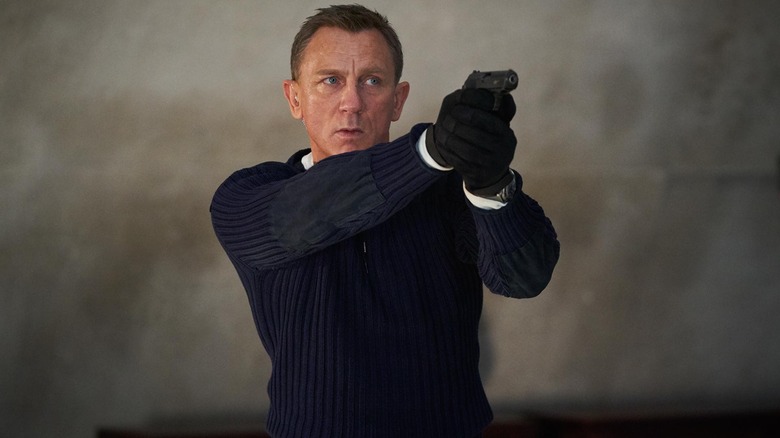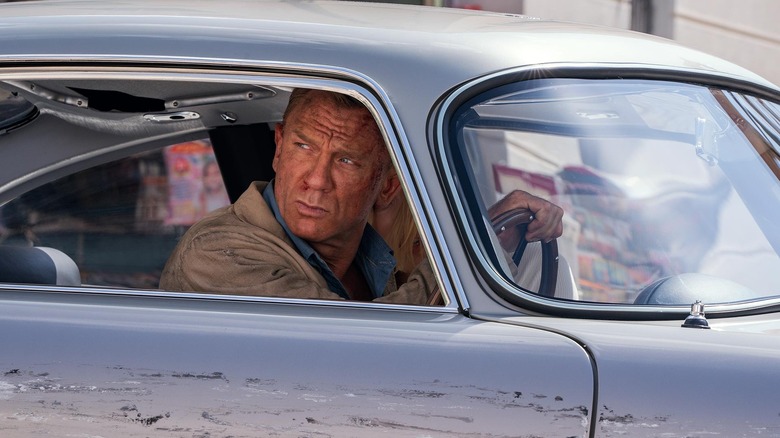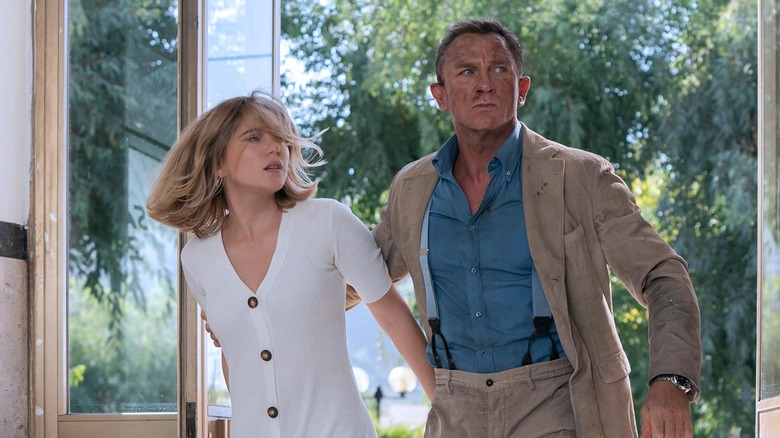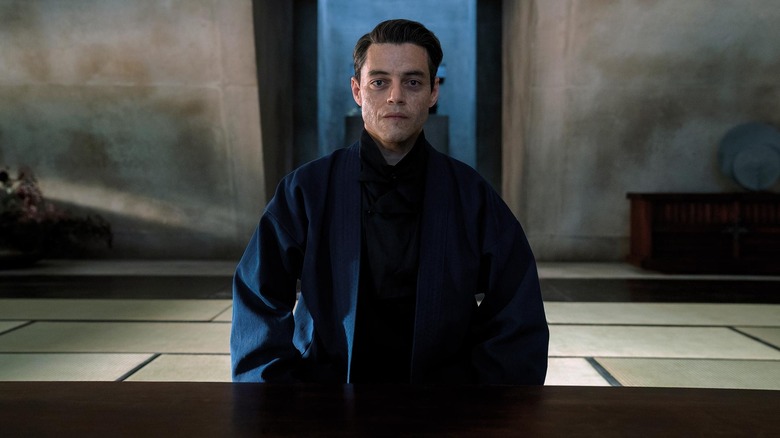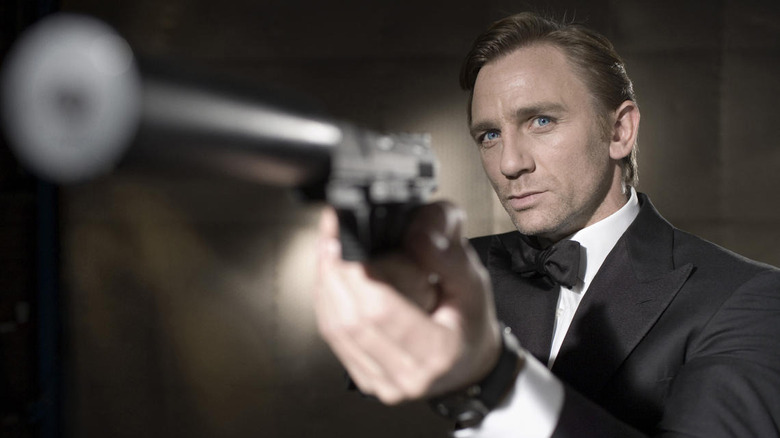No Time To Die Ending Explained: Daniel Craig's James Bond Bids Us Farewell
After what feels like an eternity for hardcore "James Bond" fans such as myself, "No Time to Die" has finally made its way to theaters. It's been nearly six years since "Spectre" hit theaters, and 15 years since Daniel Craig made his debut as 007 in "Casino Royale." With his fifth go-around, Craig is indeed saying goodbye to the role, and the way in which he leaves it behind leaves much room for discussion. With that in mind, let's break down the movie's ending and discuss what it means for Craig's Bond and, perhaps, what it might mean for the future.
Warning: major spoilers ahead for "No Time to Die." Proceed with caution.
A Brief Refresher
"No Time to Die" begins with Bond firmly in retirement after things go south with Madeleine (Léa Seydoux) shortly after the events of "Spectre." But Felix (Jeffrey Wright) manages to convince his old pal to help the CIA uncover a rogue scientist and an even deadlier virus that went missing from a secret MI6 lab, which it turns out M (Ralph Fiennes) was more than a little responsible for creating. Felix dies as the result of a double-cross from Logan (Billy Magnussen), which motivates Bond to get back into active service in a big bad way.
A globe-trotting adventure ensues that leads Bond to encounter all of the ghosts from his past: Madeleine, Blofeld (Christoph Waltz), and, in many ways, himself. Ultimately, this wildly deadly and adaptable virus, known as Heracles, was part of an evil plot headed up by Safin (Rami Malek), who happens to be a ghost from Madeleine's past. The idea is to program this virus to take out millions within the population. It truly is a classic Bond villain, mustache-twirling, evil ploy.
Ultimately, after Madeleine and, amazingly enough, his daughter named Mathilde who he didn't know existed, are captured by Safin, Bond must make his way to the villain's island lair where his evil plot is unfolding to try and rescue the woman he loves, in addition to preventing a global catastrophe. Bond teams up with Q (Ben Whishaw) and the new 007, Nomi (Lashana Lynch), to go on this seemingly impossible mission.
For Queen, Country, and Love
For as much as the final act of "No Time to Die" is motivated by Bond's desire to help Queen and Country, his motivation is far more personal this time around, which is key to the whole thing. Nomi, who insisted that Bond take back the 007 designation just ahead of the mission, flies her and Bond onto the island, which is situated in a politically precarious location, adding to the complications of the mission. Once there, they fight their way to Valdo Obruchev (David Dencik), the defected MI6 scientist who made Heracles possible. It's only at this point that they realize just how deadly Safin's plot truly is. The stakes are high. Bond leaves Nomi with Valdo so that he can seek out his beloved Madeleine and their daughter, who has been taken by Safin.
The villain and our hero finally have their big exchange in the "Dr. No"-esque lair. Safin escapes with Mathilde, which leads him on a chase to find the ladies in his life. Ultimately, Madeleine was crafty enough to escape her captors, meeting up with Bond. Then they manage to rendezvous with Mathilde, who bites Safin, resulting in the villain letting her go. A convenient plot point, I will admit. They find her hiding under a table, as her mother had taught her to hide when trouble was afoot. Following a shootout, mostly taken care of by Nomi, Bond gets them to a boat to escape the island. However, he has to stay behind and take care of business.
Any Thug Can Live
Bond is tasked with convincing M to nuke the island to do away with this deadly weapon, despite the political consequences. But the island is heavily shielded, leaving Bond to fight his way through a small army to open the blast doors, which he heroically manages to do. Just when all seems well and he's about to leave the island, Safin emerges, gun in hand, shooting Bond several times. The two get into one last epic scrape. Ultimately, Bond breaks his arm and bests his foe, but not before suffering dire consequences. Safin managed to break a special vile of Heracles on Bond's face, coded to Madeleine's DNA. This means, as Safin explains with his final breaths, if he gets anywhere near the woman he loves, or his daughter for that matter, they will die. Bond, understandably, unloads a few angry rounds into Safin before walking off to, once again, open the blast doors that Safin closed. Dick move, bro.
Bond makes his way to the roof of the building as the missiles close in. He makes a call to Q, who figures out the grim news, and then he calls Nomi to make sure they had made it to safety. Bond then has one last somber conversation with Madeleine. He declares his love for the woman. He forgives her and, it seems, forgives all of the demons of his past, in those final moments. This version of Bond was particularly tortured and, even though his final moments were filled with heartbreak, they were also filled with feelings he surely thought he'd never feel after his beloved Vesper died. Then, the missiles collide with the island. There are no two ways about it, Bond is dead.
M, Q, Moneypenny, Nomi, and the whole MI6 gang toast to Bond lovingly back at HQ. The final moments of the movie see Madeleine and Mathilde driving down a winding road, with the mother saying to her daughter that she wants to tell her the story of a man named Bond, James Bond. Credits.
A Definitive End to a Wholly Unique Bond
The Daniel Craig era of the "James Bond" franchise was markedly different than anything that came before right from the jump. The staggering leap between "Die Another Day" and "Casino Royale" simply cannot be overstated. Yes, this new 007 was gritty and a little darker than his predecessors, but it was always more than that. For most of the franchise's existence, it has been a mission of the week sort of deal. Not to say that things didn't carry over from movie to movie, but most of the films before the Craig era can be enjoyed as their own, existing largely on an island, isolated from continuity.
While "Skyfall" largely stands alone, the entirety of Craig's tenure in the role resulted in a large, five-movie arc. In the 15 years that Crag has been Bond, Hollywood became much more obsessed with interconnected storytelling, for better or for worse, and that's something that, for the first time in a meaningful way, made its way into this franchise. As a result, that necessitated a need for a definitive conclusion in "No Time to Die."
More than that, this was truly the first time ever since Sean Connery first brought Ian Fleming's beloved spy to life in 1962's "Dr. No" that the producers of the franchise knew for sure that the actor playing the role wasn't going to be returning. Craig made it crystal clear that this was going to be his last hurrah. Knowing that, coupled with the serialized nature of his Bond's five-movie arc, presented unique narrative challenges for this movie. The idea of killing Bond is bold. At no other point in the franchise's history could this idea have even been toyed with.
While fans will surely be divided on that choice (I myself am still wrestling with it), it was a way to truly close the door on Craig's legendary run in 007's shoes. Bond was offered closure. While it was, unfortunately, punctuated with being blown up by a missile, what Bond got out of those final moments, thematically speaking, is far more emotionally resonant than the Bonds of yesteryear were afforded. That is not to be dismissed out of hand. "James Bond" never saw a run like this before, and it very well might never see one again. I'll say this much; I don't envy the man who has to try and follow up this act.
"No Time to Die" is in theaters now.
